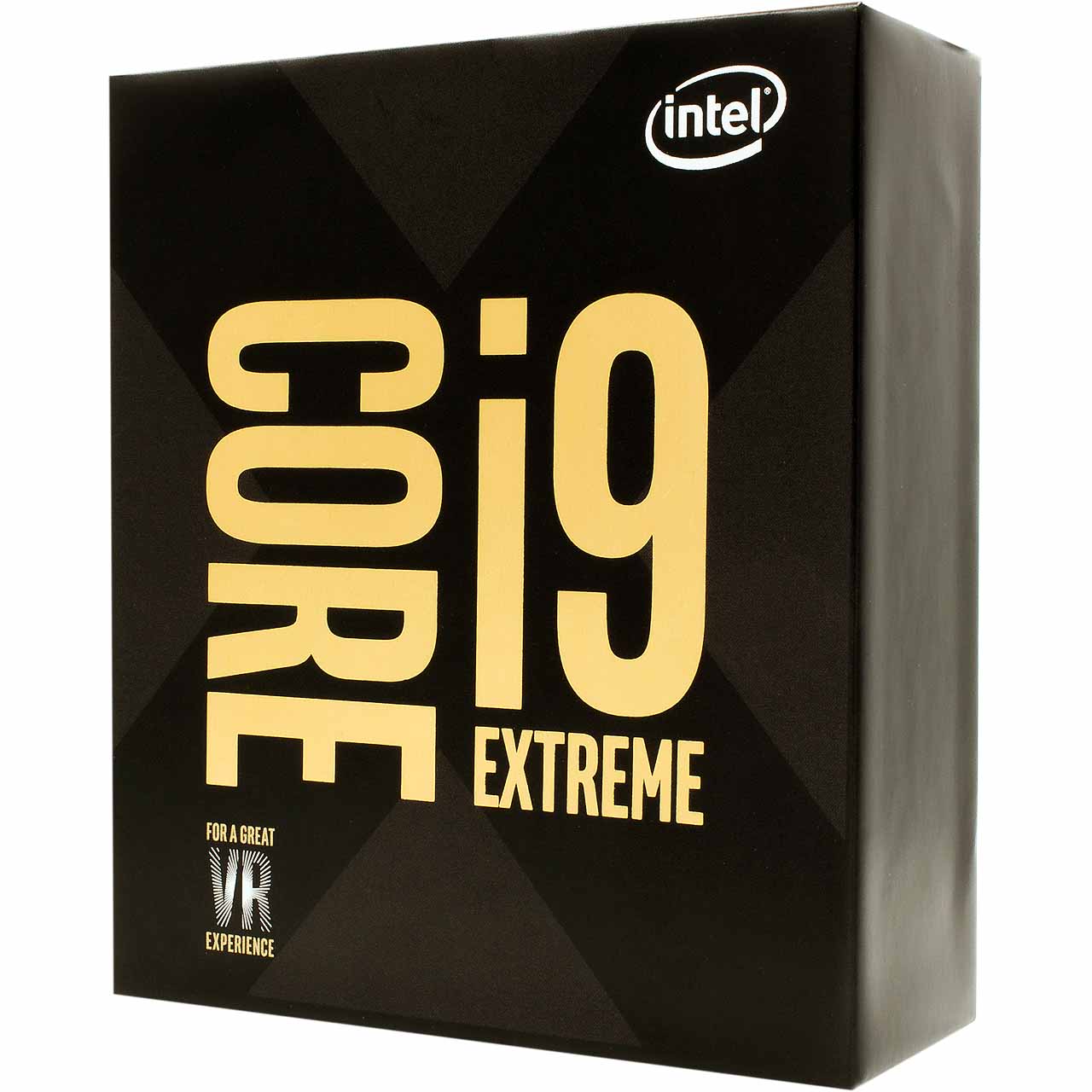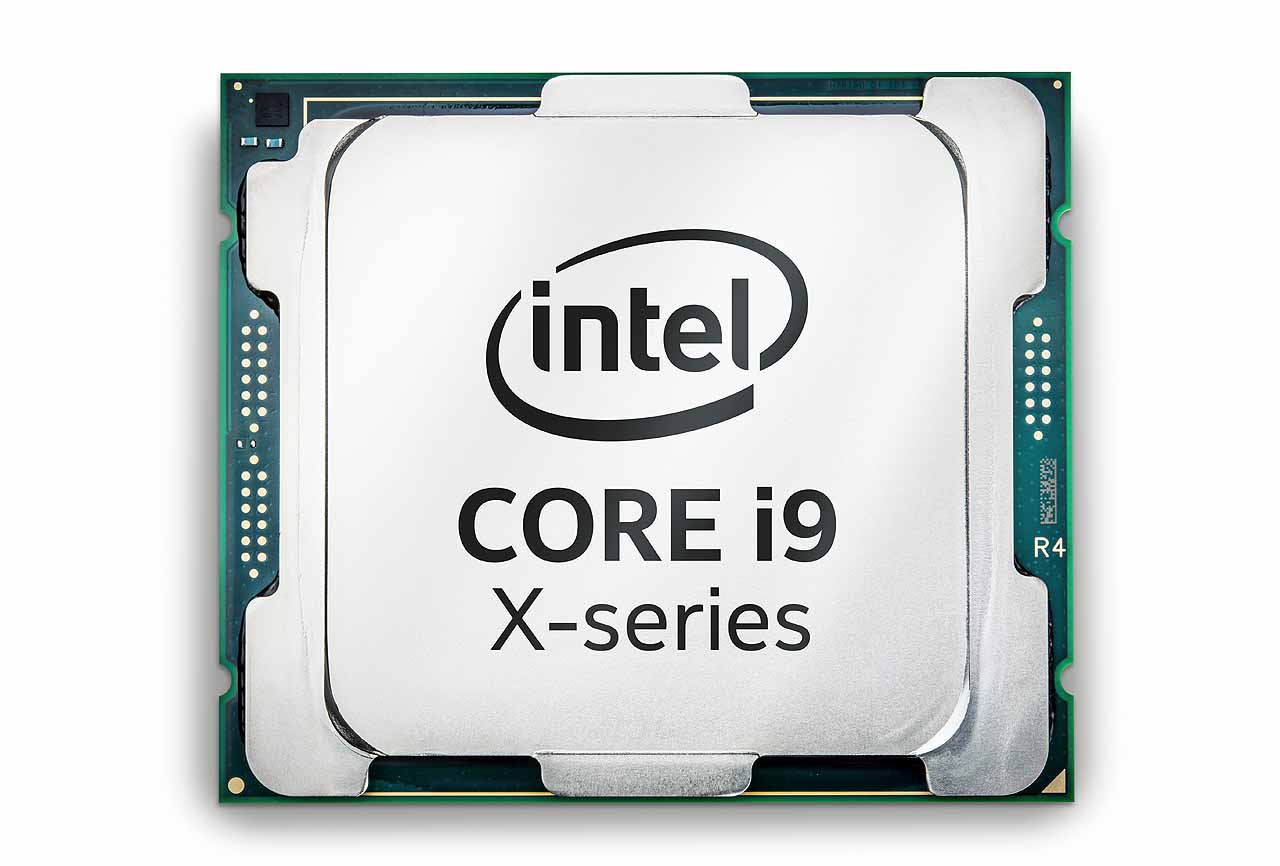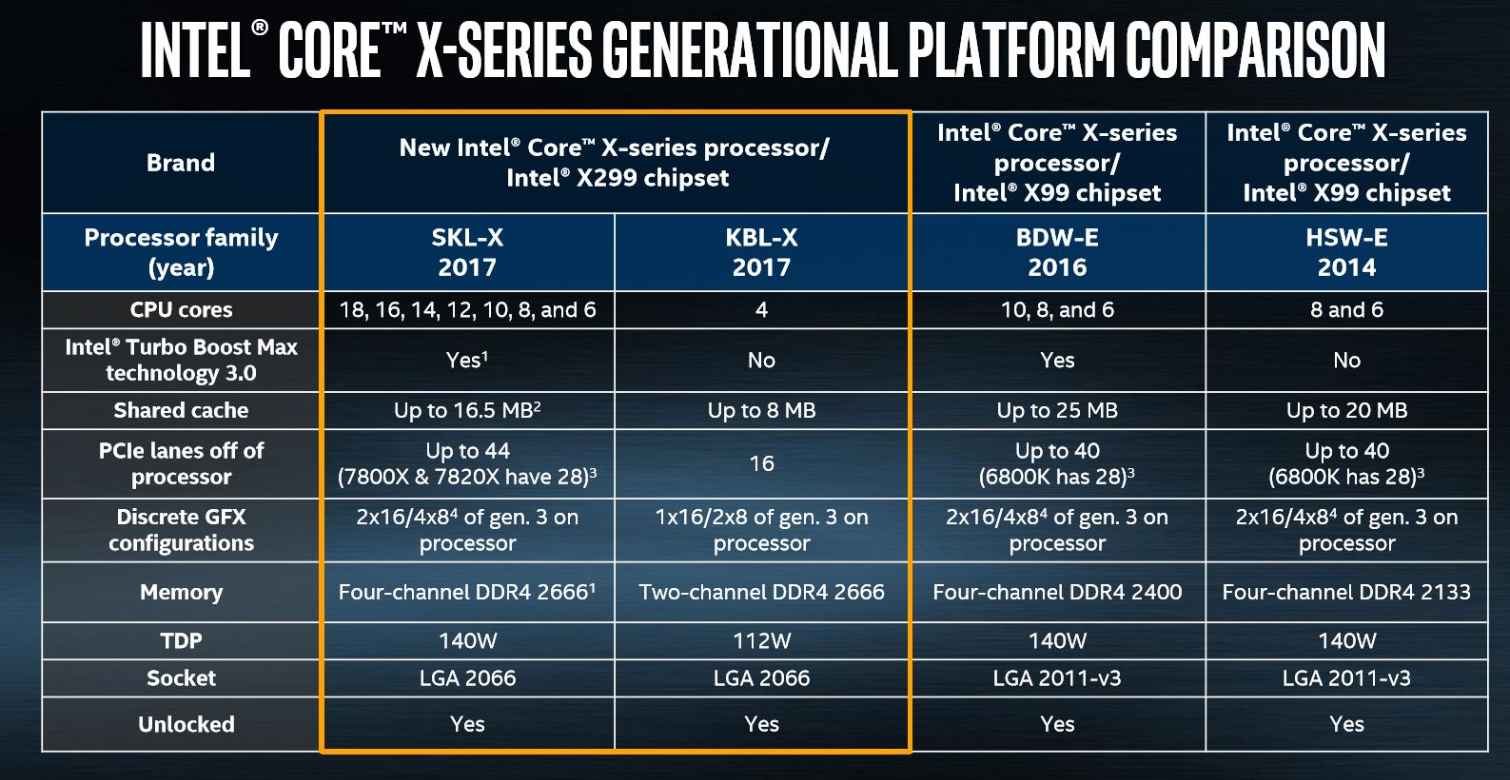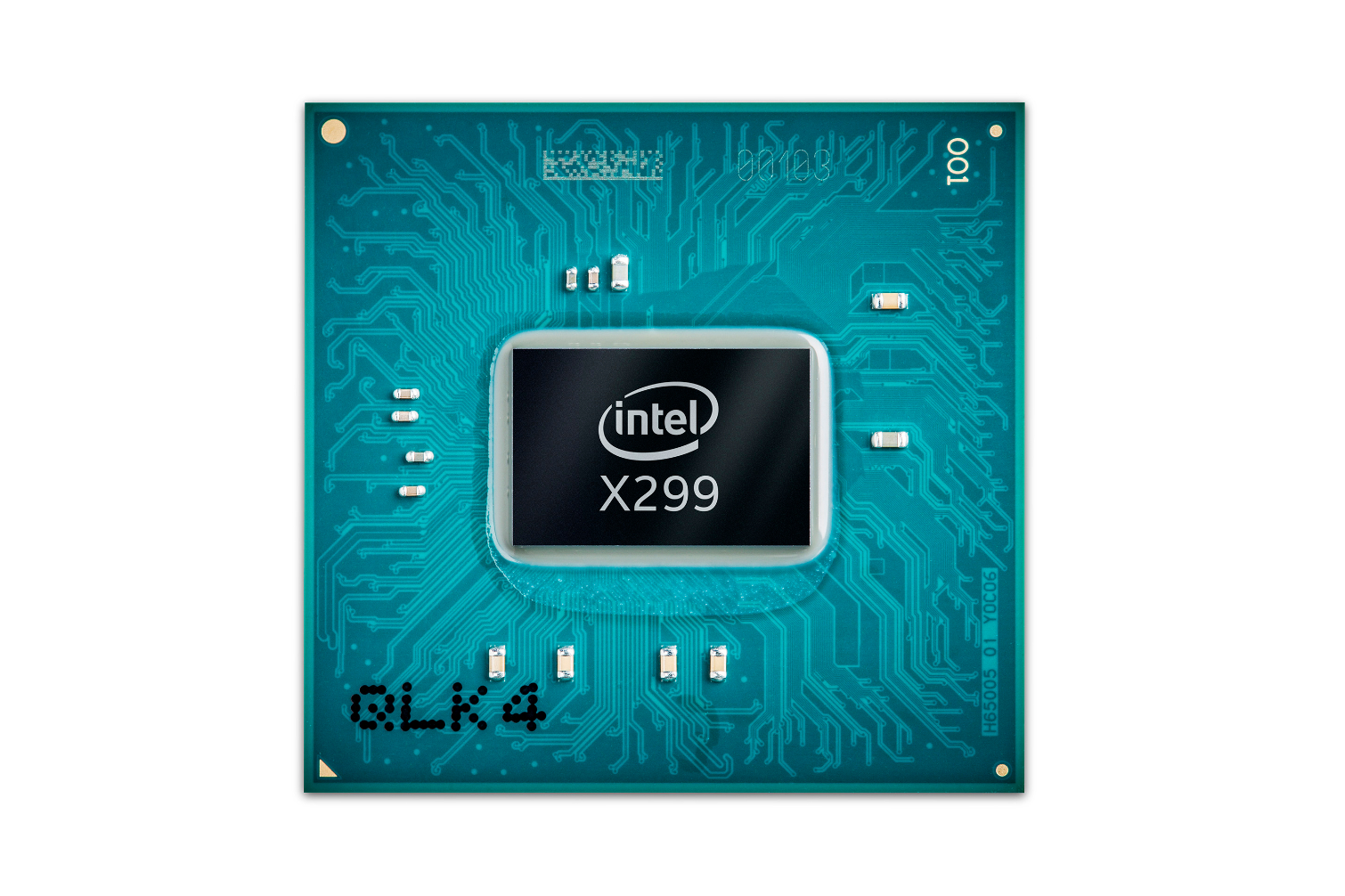Intel Fires Back, Announces X-Series 18-core Core-i9 Skylake-X, Kaby Lake-X i7, i5, X299 Basin Falls
There's no question that the resurgent AMD Ryzen processors are pressuring Intel in the mainstream CPU market. Until now, Intel has stood unflinching in the face of the renewed competition and has stoically left its price structure unchanged (except for the Core i3-7350K). And AMD's recent announcement of its beefy 16C/32T ThreadRipper processors made it clear that the company intends to bring the fight to the HEDT segment as well.
It was only a matter of time before Intel answered, either via lowering its prices or adding more cores. With the release of its new Skylake-X and Kaby Lake-X products, it appears to be doing both. Intel announced several new high-end SKUs here at Computex 2017 in Taipei today.
Intel is segmenting its new X-Series HEDT lineup into i5, i7, and i9 processors and increasing the core counts. Surprisingly, the company is offering a much lower price point for its core-heavy i9 series. Broadwell-E 10-cores weighed in at an eye-watering $1,723, but the new Skylake-X 10-core retails for only $1,000. Intel's new branding scheme finds the Skylake-X i9 series with 10, 12, 14, 16, and 18-core models with hyperthreading, which leads to a massive 36 threads on the high-end Core i9-7890XE. The i7 series spans four, six, and eight cores with hyperthreading, while the i5 series has a lone four-core, sans hyperthreading.
Intel's HEDT lineup traditionally lags a generation (or two) behind its mainstream processors. For example, we had the Broadwell-E architecture on the X99 platform while the Kaby Lake generation shipped for mainstream audiences. That trend also changes with the addition of the four-core Kaby Lake-X i5 and i9 series to the HEDT stable.
And perhaps most interestingly, we're seeing a jump in clock speeds for the HEDT lineup. The 10C/20T i9-7900X features a mundane 3.3 GHz clock, but that jumps up to 4.3 GHz with TurboBoost 2.0, and an impressive 4.5 GHz with TurboBoost 3.0. That implies a relatively high overclocking ceiling.
Intel's also reorganized its cache subsystem to boost performance. Along with the normal advances borne of better process technology, the company claims the i9 series offers 15% more performance for single threaded workloads and 10% more for multithreaded workloads.
All of the new models snap into the new LGA2066 socket on X299 "Basin Falls" chipset motherboards, which denotes a fundamental shift from the traditional server chipsets Intel used with the previous HEDT series to a client-oriented chipset.
Get Tom's Hardware's best news and in-depth reviews, straight to your inbox.
It's a lot to take in and we've got a lot of ground to cover, so let's dive in.
The Lineup
Intel announced somewhat detailed specifications for the 4-to-12-core offerings, but the 12, 14, 16, and 18 core models were missing from the original slides the company displayed during a briefing. Later, Intel added the new SKUs to an updated slide. Here's what we're looking at:
| Header Cell - Column 0 | Core i5-7640X | Core i7-7740X | Core i7-7800X | Core i7-7820X | Core i9-7900X | Core i9-7920X | Core i9-7940X | Core i9-7960X | Core i9-7980XE |
|---|---|---|---|---|---|---|---|---|---|
| Family | Kaby Lake-X | Kaby Lake-X | Skylake-X | Skylake-X | Skylake-X | Skylake-X | Skylake-X | Skylake-X | Skylake-X |
| Process | 14nm+ | 14nm+ | 14nm | 14nm | 14nm | Row 1 - Cell 6 | Row 1 - Cell 7 | Row 1 - Cell 8 | Row 1 - Cell 9 |
| Cores/Threads | 4/4 | 4/8 | 6/12 | 8/16 | 10/20 | 12/24 | 14/28 | 16/32 | 18/36 |
| Base Clock (GHz) | 4.0 | 4.3 | 3.5 | 3.6 | 3.3 | ? | ? | ? | ? |
| Intel TurboBoost 2.0 Frequency (GHz) | 4.2 | 4.5 | 4.0 | 4.3 | 4.3 | ? | ? | ? | ? |
| Intel TurboBoost 3.0 Frequency (GHz) | NA | NA | NA | 4.5 | 4.5 | ? | ? | ? | ? |
| L3 Cache | 6 | 8 | 8.25 | 11 | 13.75 | ? | ? | ? | ? |
| PCIe 3.0 Lanes | 16 | 16 | 28 | 28 | 44 | ? | ? | ? | ? |
| Memory Support | Dual Channel DDR4-2666 | Dual Channel DDR4-2666 | Quad Channel DDR4-2400 | Quad Channel DDR4-2666 | Quad Channel DDR4-2666 | ? | ? | ? | ? |
| TDP | 112W | 112W | 140W | 140W | 140W | ? | ? | ? | 165W |
| Socket | 2066 | 2066 | 2066 | 2066 | 2066 | 2066 | 2066 | 2066 | 2066 |
| RCP Pricing (USD 1K Units) | $242 | $339 | $389 | $599 | $999 | $1,199 | $1,399 | $1,699 | $1,999 |
Of course, pricing is the first thing that attracts the eye. Intel reigned in pricing on the 10-core model from $1,723 with the Broadwell-E i7-6950X to $1,000 with the Skylake-X i9-7900X, thus wiping out the i7-6950X's resale value immediately. Intel's asking price for an eight-core CPU drops from $1,089 to $599, which is still more expensive than AMD's $500 eight-core Ryzen 7 1800X. Given the Ryzen series' universally unlocked lineup, Intel also contends with the $330 8C/16T Ryzen 7 1700. Intel's six-core also drops from $583 to $339, which contends with the $249 six-core Ryzen 5 1600X and the $219 Ryzen 5 1600. Of course, similar core counts do not equate to similar performance, so it will make for an interesting battle when we factor in Intel's claimed performance increases.
The new Skylake-X models employ the Skylake Xeon HCC, MCC and LCC die. Intel increased memory support up to DDR4-2666 for all of the processors except the i7-7800X and i7-7820X. Intel hasn't released memory specifications for the higher-end CPUs, but we expect they will follow the same pattern. The Kaby Lake-X models support dual channel memory, while Skylake-X supports quad channel. The i5-7640X and i7-7740X feature a 112W TDP, while the remainder of the sub-12 core lineup has a 140W TDP. We know that the 18-core model has a 165W TDP, but await further details on the remainder of the SKUs.
The Core i9-7980XE slots in as the extreme high-end product for $1,999. Intel touts that it is the first desktop Teraflop CPU. It accommodates AVX-512, and, like the rest of the X-Series, supports Optane memory.
The Faster Things
Intel brings back support for TurboBoost (TB) 2.0 and 3.0, but the company improved TB 3.0 to direct workloads to the fastest two cores, which is an increase from the single-core support in the past. Windows 10 automatically assumes control of the TB 3.0 feature, so it no longer requires a utility or driver.
Intel reduced the shared Last Level Cache (LLC-L3) and transitioned from an inclusive scheme to non-inclusive (exclusive), apparently due to efficient caching algorithms that maximize the L2 cache hit rate. Intel also quadrupled per-core L1 capacity from 256KB to 1MB, which benefits multi-threaded performance.
The Skylake-X i7-7800X and i7-7820X feature 28 PCIe 3.0 lanes, while the remainder of the family offers 44 lanes. That's Intel's segmentation at its finest. The Kaby Lake-X models have 16 lanes. As expected, all the models have unlocked multipliers.
Intel also added a new AVX-512 ratio offset, which is a useful feature to obtain higher overclocks with non-AVX workloads. The company added memory controller trim voltage control. PEG (PCIe) and DMI overclocking also make their return. DMI overclocking is especially helpful to overcome bandwidth limitations. Intel offers its performance tuning protection plan for the new series, which is essentially an additional warranty that covers damage due to overclocking.
The X299 Basin Falls Chipset
The Kaby Lake-X and Skylake-X processors drop into the LGA 2066 socket (R4) on the newly-anointed X299 chipset. This chipset marks a shift from Intel's strategy of using server chipsets for its HEDT lineup. The X299 chipset also features a DMI 3.0 connection and the usual goodies, such as eight SATA 3.0 and 10 USB 3.0 ports, but there is a glaring lack of USB 3.1 support. Intel plans to add it in future chipsets. It also supports 30 HSIO (High Speed I/O) lanes and up to three RST PCIe 3.0 x4 storage devices. Intel's I218 Jacksonville LAN PHY also makes an appearance.
It seems odd to pair the relatively low-cost 4C/4T i5-7640X and 4C/8T i7-7740X with a (likely) expensive chipset. We asked Intel about the strategy:
Yes, we’re adding two quad-core processors for broader expandability of the platform. These parts enable customers to invest in a more powerful enthusiast platform that provides more headroom and scalability up the X-Series stack when they are ready. These two processors start with a slightly higher base frequency and provide ingredients, like higher memory speed and larger socket, for better overclocking performance compared to their mainstream counterparts. Our Intel Core i7-7700K and the S-line are still great options and by introducing the X-series we’re giving a wide variety of consumers the benefit of choice.
Intel will continue to offer socket 1151. It wouldn't be surprising to see some stratification of the X299 chipset, thus creating cheaper options, but we'll have to wait for more information.
What TDP?
The LGA2066 socket is compatible with LGA2011 cooling solutions, which is a plus. However, Intel now recommends water cooling as the minimum cooling option, which will add more cost to the overall solution.
Enter Intel's own recommended cooler. You can buy the Intel Liquid Cooling TS13X as a separate product. It features a 120mm fan, 150x118x37mm radiator, and an $85-$100 price tag.









We've included a few of the other slides in Intel's presentation deck. Interestingly, Intel has upgraded its "MegaTasking" marketing to "Extreme MegaTasking."
Closing Thoughts
Intel's HEDT lineup represents the land of high margins, and the company cashed in with its high-end products during its decade of dominance. AMD's resurgence hasn't engendered much of a response thus far from Intel in the mid-range, likely because Ryzen's lack of integrated graphics severely restricts its own addressable market, and thus the amount of share it can steal from Intel. However, the 16C/32T ThreadRipper posts a clear and present danger to Intel's HEDT lineup, particularly if AMD continues to offer disruptively low price points. Intel's first post-Ryzen salvo finds the company making moves that it arguably could have made long ago: lower prices, higher core counts, and performance-boosting optimizations to an existing architecture. That's the beauty of a newly-competitive CPU market.
Intel is rolling the X-Series out in phases, with the leading-edge 4-10 CPUs working its way to market in the coming weeks. It's fair to assume that reviews will come shortly. Intel will share more details on the remainder of the series soon.

Paul Alcorn is the Editor-in-Chief for Tom's Hardware US. He also writes news and reviews on CPUs, storage, and enterprise hardware.










